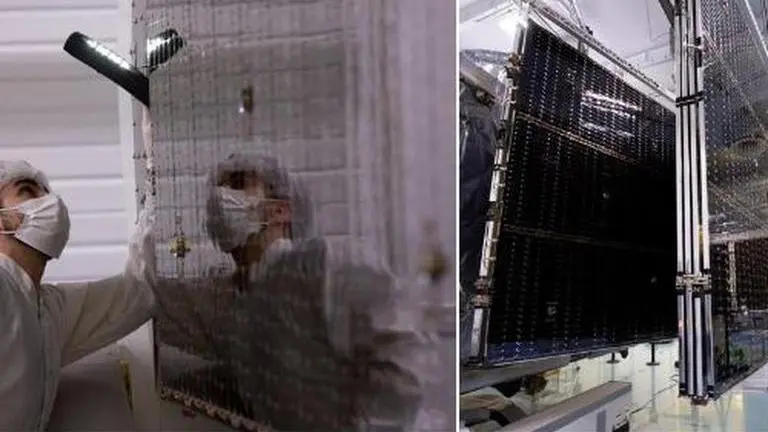Updated 7 June 2022 at 21:13 IST
ESA shares spectacular images of JUICE probe being equipped with massive solar panels
ESA's JUICE mission will be launched in 2023 to Jupiter with an aim to explore Galilean Moons- Europa, Ganymede, and Callisto- orbiting the gas giant.
- Science News
- 2 min read

Planned for launch in April 2023, the European Space Agency's (ESA) JUICE mission has entered the development phase and will soon be subjected to testing. While in the development phase, ESA has shared spectacular images of the spacecraft as it got equipped with massive solar panels, which would power the probe during its journey. Taking to Twitter, the agency revealed that the panels have been integrated into the spacecraft and the next step involves rigorous testing which will begin soon.
Some spectacular impressions of the integration and deployment of the #JUICE solar panels, ahead of the mechanical test, where the spacecraft will be vibrated & submitted to acoustic waves, simulating the stressful launch environment 🚀 https://t.co/eXOL1mKSz4 pic.twitter.com/TTg1BKUbdD
— ESA's JUICE mission (@ESA_JUICE) June 7, 2022
What is the JUICE mission?
Short for Jupiter Icy Moons Explorer, the mission, as the name suggests, is dedicated to the exploration of the gas giant's Moons, namely Europa, Ganymede, and Callisto. These Moons, along with Io-- the most volcanically active place in the solar system-- are called Galilean Moons, as they were first observed by Italian astronomer Galileo in the early 17th century. Jupiter's natural satellites have been a gripping subject for astronomers as not much is known about what happens beneath their surface.
Europa, along with its sister Moons, is also intriguing to scientists because of the oceans hidden beneath their surface. Many even believe that the oceans might be Earth-like, making them an excellent start for the search for life elsewhere in our solar system. Notably, the JUICE spacecraft will conduct the most flybys (12) near Callisto as opposed to only two across Europa. Callisto is the outermost of the four Galilean moons, owing to which it experiences the least amount of Jupiter's gravity and radiation. Moreover, scientists suspect that Callisto too has a 200km-deep ocean beneath its surface.
What would happen during the tests?
You put the spacecraft in
— Planetary Society (@exploreplanets) March 9, 2022
You vacuum the air out
You make it hot and cold
Then you shake it all about.
You do the spacecraft testing,
and you blast it all with sound.
That's what it's all about. 🚀
Here's how we test spacecraft before they launch: https://t.co/2FVmPr27o2 pic.twitter.com/f8OLARhwRK
As ESA explained, the tests would involve subjecting the spacecraft to intense vibrations and acoustic waves to prepare it for what lies ahead. Testing JUICE under vibrations would give the engineers an idea about the shortcomings of the probe during a rocket launch, a phase that causes intense shaking. The engineers are testing JUICE at ESA's Large European Acoustic Facility that simulates launch sounds.
Advertisement
Fluctuating temperatures are another major issue that can affect a spacecraft and jeopardise the mission. The probe is being prepared for such conditions inside the thermovac chambers, also called space simulators, which can achieve a space-like vacuum and simulate extreme temperature differences.
Published By : Harsh Vardhan
Published On: 7 June 2022 at 21:13 IST
